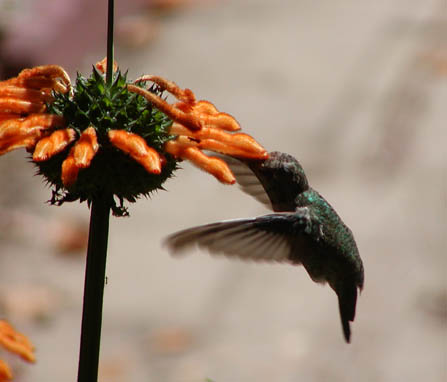
|
| Anna's hummingbird visiting Leonotis leonurus (mint family) |
| Species list |
Hybrids list |
Tubers list |
Topics list |
Site index |
What's new |
Home page |

|
| Anna's hummingbird visiting Leonotis leonurus (mint family) |
In my yard, hummingbirds visit almost every flower that has nectar, and some that don't. They're supposed to prefer red, tubular, unscented flowers, but they are most often found supping on the flowers of the lemon tree, which are white, fragrant, and open-faced. On the other hand, in the winter and early spring, bumblebees and carpenter bees bite through the sides of the red flowers of Salvia elegans out by the fence. So the equation of red tubular flowers and hummingbirds isn't 100 per cent accurate.
The hummingbirds also visit the non-red-tubular lavender. Still, they do sample the gesneriads in my yard. Aeschynanthus parasiticus, for example. And yes, the odd sinningia.
Red-flowered western-hemisphere gesneriads, such as episcias, columneas, sarmientas, and sinningias, have a special type of red pigment, called 3-deoxyanthocyanins. I call them 3-DA's, for short.
A couple of them, gesneridin and columnidin, are named after the gesneriad genera in which they were found.
The easy explanation is that
A few other species of plants make 3-DAs, but they are far away from the Gesneriaceae, so they must have developed them independently. Maize (Zea maize) from the western hemisphere and Sorghum bicolor from Africa, both members of the grass family, make 3-DAs, but for what purpose I don't know. Certainly not for attracting hummingbirds: grass family plants are wind-pollinated, and hummingbirds are not native to Africa.
Here are the known or suggested pollinator associations with the sinningias, paliavanas, and vanhoutteas. All species are hummingbird pollinated, with the exceptions listed below. Comparing these lists with the taxonomy of the sinningia alliance will make it clear that bee pollination has arisen several different times within the alliance (assuming that hummingbird pollination is the original condition for the Dircaea, Corytholoma, and Sinningia clades). For instance, S. eumorpha and S. conspicua are nested within the Dircaea clade, and all the other 25 species of the clade are hummingbird-pollinated.
These flowers are mostly purple or white, and bell-shaped, with a relatively open corolla tube. In cases where the tube is narrow (e.g. S. schiffneri), it is also short. In some cases (e.g. S. eumorpha), there are "nectar guides": stripes leading into the interior of the tube to direct the bee toward the nectar.
I believe that pollination has not actually been observed for these species in the wild, but the very narrow floral tube (too narrow for bee access) plus the white/lavender color strongly suggests butterflies.
The long tube and the fragrance mark this species as moth-pollinated.
I am not sure whether actual visits by bats to these flowers have been observed, but the greenish tinge to the flowers and their sturdy construction suggest bat pollination.